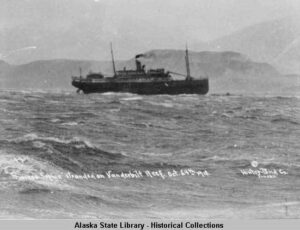- 1918
Alaska prohibition went into effect January 1 and Juneau area liquor establishments closed, except those which switched over to serving soft drinks or provided other services. A diphtheria epidemic forced school closures in the early months of the year and then the Spanish flu reached the Juneau area causing widespread illness and some deaths. Quarantines were put into effect in October for both residents and travelers.

The sinking of the Princess Sophia, stranded on Vanderbilt Reef, Oct. 24th, 1918. Alaska State Library, Winter & Pond Photo Collection, P087-1700.
The Princess Sophia ran aground on Vanderbilt Reef north of Juneau in Lynn Canal October 24 during its final seasonal run south from Skagway. Stormy weather prevented transfer of passengers to waiting rescue vessels and all aboard were lost when the ship sank the next night. It was the greatest maritime disaster on the Pacific coast, with loss of at least 353 souls (estimates vary).
Local flooding due to heavy rains in September caused at least $250,000 damage in the Juneau area, most of it along Gold Creek, with associated landslides damaging buildings, roads, bridges, power lines and other facilities. The Mendenhall River bridge was destroyed by a flood September 28.
Ready Bullion mine workings reached down 2,800 feet, the lowest level in Alaska mining history. Mine operators and other local businesses continued to report acute labor shortages as men left to go to war or to seek defense industry jobs down south.
Mrs. Grace V. Bishop, of Juneau (and later to become James Wickersham’s second wife), was the second woman in the territory to run for election as a Territorial Representative, but failed to win.
The Juneau Fish and Game Club, with the assistance of several members, planted 20,000 Colorado brook trout fry in Lawson and Kowee Creeks on Douglas Island and it was expected the ditch would soon be stocked for its entire length. Two new canneries in Juneau and one in Douglas were built and began operations to take advantage of high prices offered by the government, which was buying millions of cases of salmon to provide for Allied troops in World War I.
